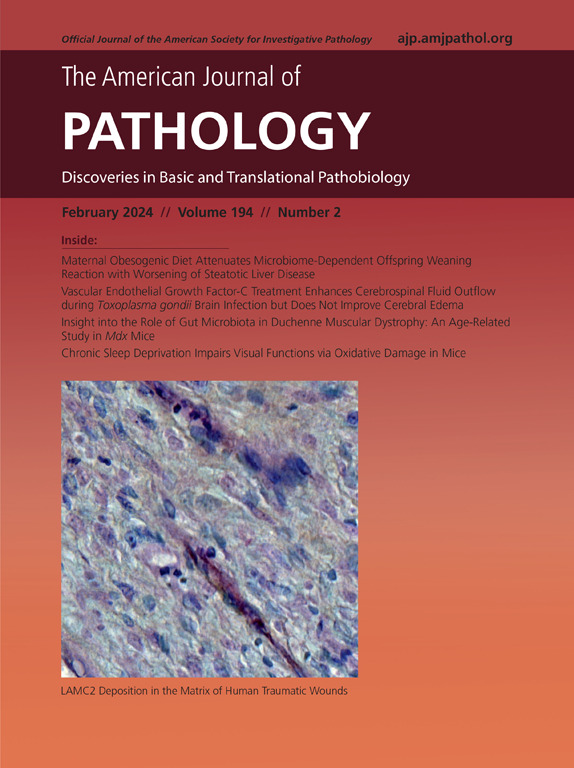Mitochondrial Protease AFG3L2 Inhibits Ferroptosis of Intestinal Epithelial Cells through PPARA/GPX4 Signaling Pathway to Improve Experimental Enteritis
IF 3.6
2区 医学
Q1 PATHOLOGY
引用次数: 0
Abstract
The pathogenesis of Crohn disease (CD) remains unclear, with mitochondrial dysfunction and ferroptosis emerging as important contributors. However, the specific mechanisms linking mitochondria, ferroptosis, and CD are not well understood. Through bioinformatics analysis using the Gene Expression Omnibus database, AFG3L2 was identified as a key mitochondrial gene and subjected to functional enrichment and immune infiltration analyses. Lipopolysaccharide-induced NCM460 cells were used in vitro. Overexpression of AFG3L2 inhibited the release of inflammatory factors, enhanced antioxidant capacity, and reduced reactive oxygen species production. In addition, AFG3L2 overexpression activated the peroxisome proliferator-activated receptor-A (PPARA) signaling pathway and promoted the nuclear translocation of PPARA. As a downstream target of PPARA, glutathione peroxidase 4 (GPX4) transcriptional activity was regulated by PPARA. AFG3L2 facilitated the binding of PPARA to the GPX4 promoter region, thereby enhancing GPX4 transcription. Importantly, the regulation of GPX4 by AFG3L2 was dependent on the activation of PPARA. 2,4,6-Trinitrobenzenesulfonic acid–induced colitis in mice was used as an in vivo model. Overexpression of AFG3L2 preserved mitochondrial ultrastructure, suppressed intestinal inflammation, and promoted the expression of PPARA and GPX4. In summary, the results of this study reveal the protective role of the AFG3L2/PPARA/GPX4 axis in maintaining intestinal mucosal integrity and suggest it as a potential therapeutic target for CD.
线粒体蛋白酶AFG3L2通过PPARA/GPX4信号通路抑制肠上皮细胞铁下垂,改善实验性肠炎。
克罗恩病(CD)的发病机制尚不清楚,线粒体功能障碍和铁下垂是重要的因素。然而,连接线粒体、铁下垂和CD的具体机制尚不清楚。通过基因表达综合数据库(Gene Expression Omnibus, GEO)的生物信息学分析,AFG3L2被鉴定为线粒体的关键基因,并进行了功能富集和免疫浸润分析。在体外,我们使用脂多糖(LPS)诱导的NCM460细胞。过表达AFG3L2抑制炎症因子的释放,增强抗氧化能力,减少活性氧(ROS)的产生。此外,AFG3L2过表达激活了PPARA信号通路,促进了PPARA的核易位。GPX4作为PPARA的下游靶点,其转录活性受PPARA调控。AFG3L2促进PPARA与GPX4启动子区结合,从而增强GPX4的转录。重要的是,AFG3L2对GPX4的调控依赖于PPARA的激活。以2,4,6 -三硝基苯磺酸(TNBS)致小鼠结肠炎为体内模型。过表达AFG3L2保存线粒体超微结构,抑制肠道炎症,促进PPARA和GPX4的表达。综上所述,本研究结果揭示了AFG3L2/PPARA/GPX4轴在维持肠粘膜完整性中的保护作用,并提示其可能是CD的潜在治疗靶点。
本文章由计算机程序翻译,如有差异,请以英文原文为准。
求助全文
约1分钟内获得全文
求助全文
来源期刊
CiteScore
11.40
自引率
0.00%
发文量
178
审稿时长
30 days
期刊介绍:
The American Journal of Pathology, official journal of the American Society for Investigative Pathology, published by Elsevier, Inc., seeks high-quality original research reports, reviews, and commentaries related to the molecular and cellular basis of disease. The editors will consider basic, translational, and clinical investigations that directly address mechanisms of pathogenesis or provide a foundation for future mechanistic inquiries. Examples of such foundational investigations include data mining, identification of biomarkers, molecular pathology, and discovery research. Foundational studies that incorporate deep learning and artificial intelligence are also welcome. High priority is given to studies of human disease and relevant experimental models using molecular, cellular, and organismal approaches.

 求助内容:
求助内容: 应助结果提醒方式:
应助结果提醒方式:


